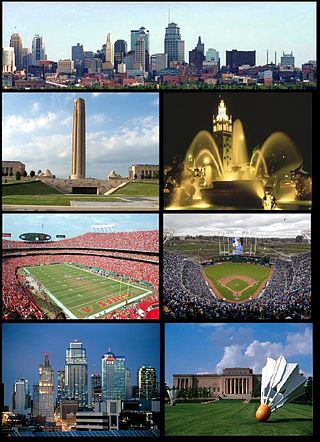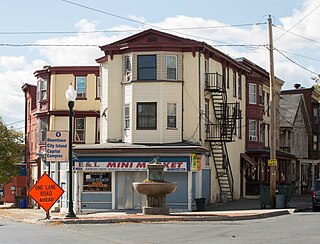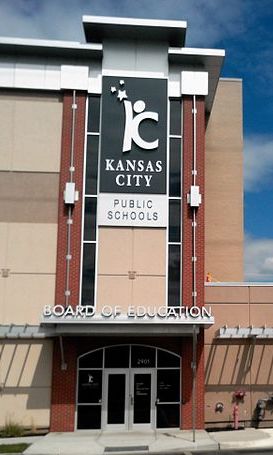
Kansas City, Missouri is the largest city in Missouri by population and area. As of the 2020 census, the city had a population of 508,090, making it the 37th most-populous city in the United States. It is the mostly suburban central city of the Kansas City metropolitan area, which straddles the Missouri–Kansas state line and has a population of 2,392,035. Most of the city lies within Jackson County, with portions spilling into Clay, Cass, and Platte counties. Kansas City was founded in the 1830s as a port on the Missouri River at its confluence with the Kansas River from the west. On June 1, 1850, the town of Kansas was incorporated; shortly after came the establishment of the Kansas Territory. Confusion between the two ensued, and the name Kansas City was assigned to distinguish them soon after.

Kansas City is the third-most populous city in the U.S. state of Kansas, and the county seat of Wyandotte County. It is an inner suburb of the older and more populous Kansas City, Missouri, after which it is named. As of the 2020 census, the population of the city was 156,607, making it one of four principal cities in the Kansas City metropolitan area. It is situated at Kaw Point, the junction of the Missouri and Kansas rivers. It is part of a consolidated city-county government known as the "Unified Government". It is the location of the University of Kansas Medical Center and Kansas City Kansas Community College.

The Kansas City metropolitan area is a bi-state metropolitan area anchored by Kansas City, Missouri. Its 14 counties straddle the border between the U.S. states of Missouri and Kansas. With 8,472 square miles (21,940 km2) and a population of more than 2.2 million people, it is the second-largest metropolitan area centered in Missouri and is the largest metropolitan area in Kansas, though Wichita is the largest metropolitan area centered in Kansas. Alongside Kansas City, Missouri, these are the suburbs with populations above 100,000: Overland Park, Kansas; Kansas City, Kansas; Olathe, Kansas; Independence, Missouri; and Lee's Summit, Missouri.

Quality Hill is a historic neighborhood near downtown Kansas City, Missouri, USA, on a 200-foot-high bluff which overlooks the confluence of the Kansas and Missouri rivers in the West Bottoms below.

Ha Ha Tonka State Park is a public recreation area encompassing over 3,700 acres (1,500 ha) on the Niangua arm of the Lake of the Ozarks, about five miles south of Camdenton, Missouri, in the United States. The state park's most notable feature is the ruins of Ha Ha Tonka, an early 20th-century stone mansion that was modeled after European castles of the 16th century.

The architecture of the Kansas City Metropolitan Area, especially Kansas City, Missouri, includes major works by some of the world's most distinguished architects and firms, including McKim, Mead and White; Jarvis Hunt; Wight and Wight; Graham, Anderson, Probst and White; Hoit, Price & Barnes; Frank Lloyd Wright; the Office of Mies van der Rohe; Barry Byrne; Edward Larrabee Barnes; Harry Weese; and Skidmore, Owings & Merrill.

Allison Hill is a neighborhood in Harrisburg, Pennsylvania, in the United States. It is located directly east of downtown Harrisburg on a bluff overlooking the older original borough along the Susquehanna River. The Hill comprises some sub-neighborhoods, such as Hillside Village; others have nicknames such as "The Ville" and the "Third Ward". Primarily, it can be separated into three smaller neighborhoods: North Allison Hill, Central Allison Hill, and South Allison Hill. It was named after William Allison, an early Harrisburg landowner who owned farms on the bluff outside of the then-Borough. First referred to as "Allison's Farm" or "Allison's Hill Farm", it finally became shortened to "Allison Hill" as the City expanded.

The West Bottoms is a historic industrial neighborhood of Kansas City, Missouri, immediately west of downtown and straddling the border of Kansas City, Missouri and Kansas City, Kansas. At the confluence of the Missouri River and the Kansas River, it faces Kaw Point, an early campsite of the Lewis and Clark Expedition. The region was originally settled by the native tribes, and this spot was permanently settled as French Bottoms in the early 1800s by François Chouteau for his trade with the tribes and early American pioneers. It is one of the oldest areas of the metro along with Westport. Its neighboring Quality Hill neighborhood is a historical center of the pioneer Town of Kansas, which became Kansas City, Missouri.
The list of neighborhoods of Kansas City, Missouri has nearly 240 neighborhoods. The list includes only Kansas City, Missouri and not the entire Kansas City metropolitan area, such as Kansas City, Kansas.
Pendleton Heights is a historic neighborhood in Kansas City, Missouri, United States. It is near the downtown highway loop, between Paseo and Chestnut Trafficway to the west and east, and Independence Avenue and Cliff Drive to the south and north.

The Metro Area Express (MAX) is an express bus service with bus rapid transit characteristics run by the Kansas City Area Transportation Authority in Kansas City, Missouri, United States.

Kersey Coates was a businessman from Kansas City, in the U.S. state of Missouri, who developed Quality Hill, founded the Kansas City Board of Trade, and was among those who attracted the Hannibal & St. Joseph Railroad to the city.

Kansas City 33 School District, operating as Kansas City Public Schools or KCPS, is a school district headquartered at 2901 Troost Avenue in Kansas City, Missouri, United States.

The Paseo is a major north–south parkway in Kansas City, Missouri. As the city's first major boulevard, it runs approximately 10 miles (16 km) through the center of the city: from Cliff Drive and Lexington Avenue on the bluffs above the Missouri River in the Pendleton Heights historic neighborhood, to 85th Street and Woodland Avenue. The parkway holds 223 acres (0.90 km2) of boulevard parkland dotted with several Beaux-Arts-style decorative structures and architectural details maintained by the city's Parks and Recreation department.

Hyde Park is a historic residential neighborhood and city park in Kansas City, Missouri.

Squier Park is a historic neighborhood in midtown Kansas City, Missouri, USA. It encompasses sixteen blocks bounded by Armour Boulevard on the north, 39th Street on the south, Troost Avenue on the west, and Paseo Boulevard on the east. It is primarily a residential neighborhood, with businesses along Troost Avenue. It has been listed on the National Register of Historic Places since 2012.
Troost Avenue is one of the major streets in Kansas City, Missouri and the Kansas City metropolitan area. It is 10.7 miles long, from the north point at 4th Street to the south point at Bannister Road.
Tiffany Springs is a neighborhood of Kansas City, Missouri, United States. It was founded by Flavel B. Tiffany in 1891 as Artesian Springs, intended to compete with Excelsior Springs, Missouri.















